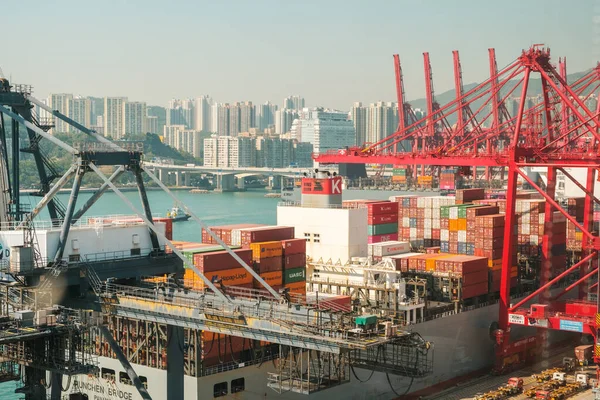On the road leading to Shanghai’s bustling Waigaoqiao container port, truck traffic was light on a recent weekday. Not far away, row after row of corrugated-metal containers test the limits of stacking in the limited port space.
Most of these cargo containers remain empty, according to Wang, a worker at the port who decline to give his full name because he was not authorised to speak to the press.
“We’ve been a bit busier than the past two months, but the change hasn’t been major,” Wang said. “Trucks had to queue in long lines in the past, waiting to load and unload. But now, as you can see, the road is clear.”
Although the latest official figures suggest there was a considerable rebound in China’s foreign trade last month, logistics workers in Shanghai – the world’s largest container port – have found the recovery slow, and their long-term outlook remains cautiously pessimistic.
China’s exports saw a better-than-expected growth rate of 14.8 per cent in March from the same period last year, recovering after a 6.8 per cent fall in combined figures for January and February, the General Administration of Customs said on Thursday. Imports also improved, with a less-than-expected 1.4 per cent decline in March from a year earlier, it said.
Hua Yuting, a manager with the China Ocean Shipping Agency in Shanghai, said the shipping industry, a barometer for global trade, has witnessed some pickup since March, but more time is needed to see substantial improvement.
“Due to disruptions caused by Covid-induced lockdowns in the past couple of years, many companies have shifted to Southeast Asia to source goods. The US route is doing especially badly,” she said.
“The impact is long-term, because when a client is lost, it’s not like you can [easily] win them back once the country reopens,” she added.
Meanwhile, those mountains of empty containers are still a common sight at several of Shanghai’s ports, despite a reportedly moderate decline in that number at some other major ports in China, including in Ningbo and Shenzhen.
Lu Qinglin was among dozens of drivers who risked being fined for parking their trucks beside the roads between the Wusong and Waigaoqiao ports to avoid parking fees because they simply did not have work.
“There are 50,000 registered container trucks in Shanghai, and only 30,000 of them are needed, based on the current demand,” said Lu, who has been driving a cargo truck in the Yangtze River Delta since 2010.
“In Kunshan, 10 out of 100 factories have moved to Southeast Asian countries such as Vietnam,” he said, referring to a manufacturing base of high-technology products in Jiangsu province, near Shanghai, where he often loads goods.
Less cargo, declining delivery fees and rising gas prices have cut Lu’s monthly income by about two-thirds. Between 2010 and 2021, he had a steady income of 15,000 yuan (US$2,200) per month. But since early last year, he said he has been making just 4,000 to 5,000 yuan a month.
While Chinese leaders have stressed the need to shift priorities and support from exports to domestic consumption, to fuel economic growth for several years to come, foreign trade remains high on Beijing’s agenda as it pursues a GDP target of “around 5 per cent” this year.
China’s newly appointed premier, Li Qiang, ordered officials at a cabinet meeting last week to “try every means” to grow trade with developed countries, and he asked companies to further explore markets in emerging economies.
The container availability index (CAx), a tool used to measure import and export moves of full containers, has remained elevated, with a rating of 0.64 at ports in Shanghai for both 20-foot and 40-foot containers since the beginning of the year, according to container-monitoring platform Container xChange. A reading of 0.5 suggests a balanced market, below 0.5 indicates a shortage of containers, and above 0.5 reflects an excess of containers.
Traditionally, the CAx values in Shanghai in a year’s first quarter are much less than the 0.5 balance, because there are fewer inbound containers than outbound containers during this period due to a seasonal decrease in demand and Lunar New Year shutdowns, the platform said.
Since September, the index in Shanghai has consistently been higher than in the past two years, and there has been a similar trend at ports in Shenzhen and Tianjin, it found.
“With the current situation involving a demand deficit, and more containers lying at the ports, inbounds are significantly higher in China,” it said in an analysis.
Ocean freight rates, which are highly affected by international trade, have dipped in China since peaking early last year. The China Containerised Freight Index, which is compiled weekly by the Shanghai Shipping Exchange to track ocean freight prices of containers departing from China, has slumped by more than a quarter since the end of last year, closing at 942.14 on Friday.
While ports inundated with empty containers are not a unique sight in China amid sluggish global trade, Chinese authorities have attributed it to a surge in container construction in 2021 and low warehousing costs at Chinese ports.
“To some extent, a large number of empty boxes at our ports shows that the global market is still optimistic about China’s exports in future,” said Yu Jianhua, minister of the General Administration of Customs, at a press conference last month.
In a recent global survey of 660 supply-chain professionals, most said they expected the peak season in 2023 to be better than last year, according to Container xChange.
“The industry also expects China’s consumer demand to rebound, albeit subdued,” it said in its monthly container market forecaster for April.
A process of diversification is taking place in international trade, as more companies reduce their reliance on one production and supply-chain hub by diversifying operations and creating a smaller trading pattern, according to Christian Roeloffs, the platform’s co-founder and CEO.
“It will cause a boom in the regional trade within Asia and also lead to more locations adding to direct trade from the region to North America or to Europe,” he said. “So, diversification will play a role, and generally this will soak up more capacity than what we would have had on transpacific China to the USA or China to Europe alone.”
But Hua, from the shipping agency, expressed doubts as to whether China will be able to fully recover to pre-pandemic levels.
“It’s hard to say how much farther it can rebound. Why should a client who’s left for Southeast Asia return if the costs there are lower and quality can be ensured,” she said. “They would at least choose to put their eggs in different baskets, even if they came back.”
And for drivers such as Lu, even after seeing a slight increase in business since last month, there’s little hope that they will see a fundamental change this year.
“I’m now trying to sell my truck and find a new job – just waiting for an acceptable price. I don’t think the good days will come back,” he said. – SCMP









